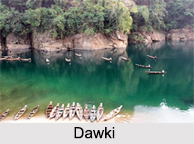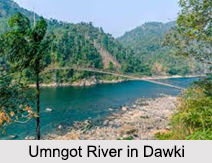 Dawki is a town in West Jaintia Hills district, Meghalaya. It is one of the most picturesque sites of Meghalaya Tourism. Dawki is known for its pristine lush green surroundings, and it is truly a blessing in disguise. The town is not just a tourist attraction but also one of the nearest "Gateways to Bangladesh". It has served as a trade centre between the two countries for a long time. Dawki is mainly known for coal mines and limestone exports which keep the trade between India and Bangladesh.
Dawki is a town in West Jaintia Hills district, Meghalaya. It is one of the most picturesque sites of Meghalaya Tourism. Dawki is known for its pristine lush green surroundings, and it is truly a blessing in disguise. The town is not just a tourist attraction but also one of the nearest "Gateways to Bangladesh". It has served as a trade centre between the two countries for a long time. Dawki is mainly known for coal mines and limestone exports which keep the trade between India and Bangladesh.
Situated on the Umngot River, the place is often selected as the venue of the annual boat race that is held during March-April at Umsyiem. The Umngot River is the natural border between Ri Pnar or Jaintia Hills with Hima Khyrim or Khasi hills which is connected with a bridge that lies above the river. This place is mainly known for its scenic beauty that shares some panoramic view of the gorges and ravines of the Khasi hills and Jaintia hills.
Location of Dawki
Dawki lies about 82 km from Shillong and it is just 2 km away from Bangladesh border. Located in the West Khasi Hills district of Meghalaya, this place has temperate climate. As the place is located at the borders of India and Bangladesh, it is a major centre for export and import transactions in the region.
 Places to Visit in Dawki
Places to Visit in Dawki
The biggest attraction of this region is Umngot River and the connecting bridge which is often visited by the tourist of India. Umngot river in Dawki is one the cleanest rivers in India. Boat ride in this pristine river is a major tourist attraction. Dawki Bridge is a suspension bridge over the Umngot River. It was constructed in 1932 by the British. Travellers enjoy being part of this magnificent scenery. Soothing natural beauty of this town and rushing water of Umngot River is a perfect combination for all kinds of visitors either looking for peace or for an adrenalin rush through adventure.
Visiting Information of Dawki
Dawki is well-connected by road from Shillong. It is situated on the south-eastern border of Meghalaya, around 82 km south of Shillong. However, it is better to hire a cab or a taxi to reach Dawki. Buses are also available from Shillong. Guwahati Railway Station is the nearest railway station. Dawki is around 180km from Guwahati.



















